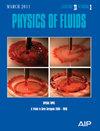Mechanisms of fluid–structure interaction in an underwater muzzle brake
IF 4.1
2区 工程技术
Q1 MECHANICS
引用次数: 0
Abstract
A fluid–structure interaction (FSI) mechanism of a shock-type underwater muzzle brake is examined. A bidirectional coupling interior ballistic approach is employed to achieve accurate projectile velocity. A velocity–pressure separation solution algorithm, semi-implicit method for pressure-linked equations and the Schnerr–Sauer cavitation model are used to address the volume of fluid multiphase Navier–Stokes equations with compressible cavitation. The full ballistic muzzle flow field distribution is comprehensively modeled. Analyzing the force and flow parameters of the T-shaped underwater muzzle brake based on the numerical solution reveals detailed insights. The underwater muzzle brake provides significant braking force in the interior ballistic period due to the presence of the water medium, which is quite different from air launch. Moreover, while both the internal and intermediate ballistic periods utilize the kinetic energy of the fluid against the wall, the muzzle brake principle in the interior ballistic period is a positive kinetic impact of water, mainly dependent on the flow velocity inside the barrel, and provides 17% recoil impulse. The side holes are significantly affected by cavitation phenomena. In contrast, during the intermediate ballistic period, the kinetic impact of gas, primarily dependent on the high-pressure gas expansion, decreases exponentially with time and provides 36% recoil impulse.水下枪口制动器中流体与结构的相互作用机理
研究了冲击型水下枪口制动器的流固耦合(FSI)机制。采用双向耦合内部弹道方法来实现精确的弹丸速度。采用速度-压力分离求解算法、压力关联方程的半隐式方法和 Schnerr-Sauer 汽蚀模型来解决具有可压缩汽蚀的流体体积多相 Navier-Stokes 方程。对全弹道枪口流场分布进行了全面建模。在数值解的基础上分析了 T 型水下枪口制动器的力和流动参数,获得了详细的见解。由于水介质的存在,水下枪口制动器在内部弹道期间提供了显著的制动力,这与空气发射截然不同。此外,内弹道期和中间弹道期都是利用流体对弹道壁的动能,而内弹道期的枪口制动原理是水的正动能冲击,主要取决于枪管内的流速,可提供 17% 的后坐冲力。侧孔受空化现象的影响很大。相反,在中间弹道期间,气体的动能冲击主要取决于高压气体膨胀,随时间呈指数下降,提供 36% 的后坐力冲力。
本文章由计算机程序翻译,如有差异,请以英文原文为准。
求助全文
约1分钟内获得全文
求助全文
来源期刊

Physics of Fluids
物理-力学
CiteScore
6.50
自引率
41.30%
发文量
2063
审稿时长
2.6 months
期刊介绍:
Physics of Fluids (PoF) is a preeminent journal devoted to publishing original theoretical, computational, and experimental contributions to the understanding of the dynamics of gases, liquids, and complex or multiphase fluids. Topics published in PoF are diverse and reflect the most important subjects in fluid dynamics, including, but not limited to:
-Acoustics
-Aerospace and aeronautical flow
-Astrophysical flow
-Biofluid mechanics
-Cavitation and cavitating flows
-Combustion flows
-Complex fluids
-Compressible flow
-Computational fluid dynamics
-Contact lines
-Continuum mechanics
-Convection
-Cryogenic flow
-Droplets
-Electrical and magnetic effects in fluid flow
-Foam, bubble, and film mechanics
-Flow control
-Flow instability and transition
-Flow orientation and anisotropy
-Flows with other transport phenomena
-Flows with complex boundary conditions
-Flow visualization
-Fluid mechanics
-Fluid physical properties
-Fluid–structure interactions
-Free surface flows
-Geophysical flow
-Interfacial flow
-Knudsen flow
-Laminar flow
-Liquid crystals
-Mathematics of fluids
-Micro- and nanofluid mechanics
-Mixing
-Molecular theory
-Nanofluidics
-Particulate, multiphase, and granular flow
-Processing flows
-Relativistic fluid mechanics
-Rotating flows
-Shock wave phenomena
-Soft matter
-Stratified flows
-Supercritical fluids
-Superfluidity
-Thermodynamics of flow systems
-Transonic flow
-Turbulent flow
-Viscous and non-Newtonian flow
-Viscoelasticity
-Vortex dynamics
-Waves
 求助内容:
求助内容: 应助结果提醒方式:
应助结果提醒方式:


